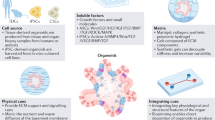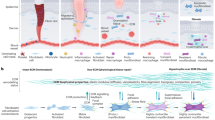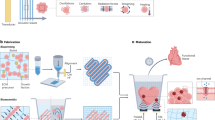Abstract
Strategies for the biological repair of intervertebral discs derive from the premise that disc degeneration results from impaired cellular activity and, therefore, that these structures can be induced to regenerate by implanting active cells or providing factors that restore normal cellular activity. In vitro and animal studies using this approach have had some success, but whether this success can be reproduced in degenerate human lumbar discs is unknown. Successful repair requires that the disc cells remain viable and active; they therefore need an adequate supply of nutrients. However, as the disc degenerates, the nutrient supply decreases, thereby limiting cell activity and viability. Current biologic approaches might place additional demands on an already precarious nutrient supply. Here, we discuss whether the loss of nutrients associated with disc degeneration limits the effectiveness of biologic approaches, and indicate that this neglected problem requires investigation if clinical application of such therapies is to succeed.
This is a preview of subscription content, access via your institution
Access options
Subscribe to this journal
Receive 12 print issues and online access
$209.00 per year
only $17.42 per issue
Buy this article
- Purchase on Springer Link
- Instant access to full article PDF
Prices may be subject to local taxes which are calculated during checkout



Similar content being viewed by others
References
Vos, T. et al. Years lived with disability (YLDs) for 1160 sequelae of 289 diseases and injuries 1990–2010: a systematic analysis for the Global Burden of Disease Study 2010. Lancet 380, 2163–2196 (2012).
Roberts, S., Evans, H., Trivedi, J. & Menage, J. Histology and pathology of the human intervertebral disc. J. Bone Joint Surg. Am. 88 (Suppl. 2), 10–14 (2006).
Adams, M. A. & Roughley, P. J. What is intervertebral disc degeneration, and what causes it? Spine 31, 2151–2161 (2006).
Thompson, J. et al. Preliminary evaluation of a scheme for grading the gross morphology of the human intervertebral disc. Spine 15, 411–415 (1990).
Pfirrmann, C. W., Metzdorf, A., Zanetti, M., Hodler, J. & Boos, N. Magnetic resonance classification of lumbar intervertebral disc degeneration. Spine (Phila. Pa 1976) 26, 1873–1878 (2001).
Battie, M. C. & Videman, T. Lumbar disc degeneration: epidemiology and genetics. J. Bone Joint Surg. Am. 88 (Suppl. 2), 3–9 (2006).
Sivan, S. S. et al. Biochemical composition and turnover of the extracellular matrix of the normal and degenerate intervertebral disc. Eur. Spine J. http://dx.doi.org/10.1007/s00586-013-2767-8.
Grunhagen, T., Shirazi-Adl, A., Fairbank, J. C. & Urban, J. P. Intervertebral disk nutrition: a review of factors influencing concentrations of nutrients and metabolites. Orthop. Clin. North Am. 42, 465–477 (2011).
Roberts, S., Menage, J. & Urban, J. P. Biochemical and structural properties of the cartilage end-plate and its relation to the intervertebral disc. Spine (Phila. Pa 1976) 14, 166–174 (1989).
Urban, J. P., Holm, S., Maroudas, A. & Nachemson, A. Nutrition of the intervertebral disc: effect of fluid flow on solute transport. Clin. Orthop. Relat. Res. 170, 296–302 (1982).
Boubriak, O. A., Watson, N., Sivan, S. S., Stubbens, N. & Urban, J. P. Factors regulating viable cell density in the intervertebral disc: blood supply in relation to disc height. J. Anat. 222, 341–348 (2013).
Horner, H. A. & Urban, J. P. 2001 Volvo Award Winner in Basic Science Studies: Effect of nutrient supply on the viability of cells from the nucleus pulposus of the intervertebral disc. Spine (Phila. Pa 1976) 26, 2543–2549 (2001).
Bibby, S. R., Fairbank, J. C., Urban, M. R. & Urban, J. P. Cell viability in scoliotic discs in relation to disc deformity and nutrient levels. Spine (Phila. Pa 1976) 27, 2220–2228 (2002).
Stephan, S., Johnson, W. E. & Roberts, S. The influence of nutrient supply and cell density on the growth and survival of intervertebral disc cells in 3D culture. Eur. Cell. Mater. 22, 97–108 (2011).
Bartels, E. M., Fairbank, J. C., Winlove, C. P. & Urban, J. P. Oxygen and lactate concentrations measured in vivo in the intervertebral discs of patients with scoliosis and back pain. Spine (Phila. Pa 1976) 23, 1–7 (1998).
Kobayashi, S., Meir, A. & Urban, J. Effect of cell density on the rate of glycosaminoglycan accumulation by disc and cartilage cells in vitro. J. Orthop. Res. 26, 493–503 (2008).
Huang, Y. C., Leung, V. Y., Lu, W. W. & Luk, K. D. The effects of microenvironment in mesenchymal stem cell-based regeneration of intervertebral disc. Spine J. 13, 352–362 (2013).
Wuertz, K., Godburn, K. & Iatridis, J. C. MSC response to pH levels found in degenerating intervertebral discs. Biochem. Biophys. Res. Commun. 379, 824–829 (2009).
Kauppila, L. I. Atherosclerosis and disc degeneration/low-back pain--a systematic review. Eur. J. Vasc Endovasc Surg. 37, 661–670 (2009).
Tokuda, O., Okada, M., Fujita, T. & Matsunaga, N. Correlation between diffusion in lumbar intervertebral disks and lumbar artery status: evaluation with fresh blood imaging technique. J. Magn. Reson. Imaging 25, 185–191 (2007).
Rajasekaran, S., Venkatadass, K., Naresh Babu, J., Ganesh, K. & Shetty, A. P. Pharmacological enhancement of disc diffusion and differentiation of healthy, ageing and degenerated discs: Results from in-vivo serial post-contrast MRI studies in 365 human lumbar discs. Eur. Spine J. 17, 626–643 (2008).
Turgut, M., Uysal, A., Uslu, S., Tavus, N. & Yurtseven, M. E. The effects of calcium channel antagonist nimodipine on end-plate vascularity of the degenerated intervertebral disc in rats. J. Clin. Neurosci. 10, 219–223 (2003).
Holm, S. & Nachemson, A. Nutrition of the intervertebral disc: acute effects of cigarette smoking. An experimental animal study. Ups. J. Med. Sci. 93, 91–99 (1988).
Nachemson, A., Lewin, T., Maroudas, A. & Freeman, M. A. In vitro diffusion of dye through the end-plates and the annulus fibrosus of human lumbar inter-vertebral discs. Acta Orthop. Scand. 41, 589–607 (1970).
Benneker, L. M., Heini, P. F., Alini, M., Anderson, S. E. & Ito, K. 2004 Young Investigator Award Winner: vertebral endplate marrow contact channel occlusions and intervertebral disc degeneration. Spine (Phila. Pa 1976) 30, 167–173 (2005).
Hristova, G. I. et al. Calcification in human intervertebral disc degeneration and scoliosis. J. Orthop. Res. 29, 1888–1895 (2011).
Roberts, S., Urban, J. P., Evans, H. & Eisenstein, S. M. Transport properties of the human cartilage endplate in relation to its composition and calcification. Spine (Phila. Pa 1976) 21, 415–420 (1996).
Wang, Y., Videman, T. & Battie, M. C. Lumbar vertebral endplate lesions: prevalence, classification, and association with age. Spine (Phila. Pa 1976) 37, 1432–1439 (2012).
Ogata, K. & Whiteside, L. A. 1980 Volvo award winner in basic science. Nutritional pathways of the intervertebral disc. An experimental study using hydrogen washout technique. Spine (Phila. Pa 1976) 6, 211–216 (1981).
Rajasekaran, S. et al. ISSLS prize winner: A study of diffusion in human lumbar discs: a serial magnetic resonance imaging study documenting the influence of the endplate on diffusion in normal and degenerate discs. Spine (Phila. Pa 1976) 29, 2654–2667 (2004).
Stefanovic-Racic, M., Stadler, J., Georgescu, H. I. & Evans, C. H. Nitric oxide and energy production in articular chondrocytes. J. Cell Physiol. 159, 274–280 (1994).
Risbud, M. V. & Shapiro, I. M. Role of cytokines in intervertebral disc degeneration: pain and disc content. Nat. Rev. Rheumatol. 10, 44–56 (2014).
Shirazi-Adl, A., Taheri, M. & Urban, J. P. Analysis of cell viability in intervertebral disc: Effect of endplate permeability on cell population. J. Biomech. 43, 1330–1336 (2010).
Nomura, T., Mochida, J., Okuma, M., Nishimura, K. & Sakabe, K. Nucleus pulposus allograft retards intervertebral disc degeneration. Clin. Orthop. Relat. Res. 389, 94–101 (2001).
Kregar Velikonja, N. et al. Cell sources for nucleus pulposus regeneration. Eur. Spine J. http://dx.doi.org/10.1007/s00586-013-3106-9.
Pereira, D. R., Silva-Correia, J., Oliveira, J. M. & Reis, R. L. Hydrogels in acellular and cellular strategies for intervertebral disc regeneration. J. Tissue Eng. Regen. Med. 7, 85–98 (2013).
Hudson, K. D., Alimi, M., Grunert, P., Hartl, R. & Bonassar, L. J. Recent advances in biological therapies for disc degeneration: tissue engineering of the annulus fibrosus, nucleus pulposus and whole intervertebral discs. Curr. Opin. Biotechnol. 24, 872–879 (2013).
Yoshikawa, T., Ueda, Y., Miyazaki, K., Koizumi, M. & Takakura, Y. Disc regeneration therapy using marrow mesenchymal cell transplantation: a report of two case studies. Spine (Phila. Pa 1976) 35, E475–E480 (2010).
Orozco, L. et al. Intervertebral disc repair by autologous mesenchymal bone marrow cells: a pilot study. Transplantation 92, 822–828 (2011).
Meisel, H. J. et al. Clinical experience in cell-based therapeutics: disc chondrocyte transplantation A treatment for degenerated or damaged intervertebral disc. Biomol. Eng. 24, 5–21 (2007).
Coric, D., Pettine, K., Sumich, A. & Boltes, M. O. Prospective study of disc repair with allogeneic chondrocytes presented at the 2012 Joint Spine Section Meeting. J. Neurosurg. Spine 18, 85–95 (2013).
US National Library of Medicine. ClinialTrial.gov [online], (2013).
US National Library of Medicine. ClinialTrial.gov [online], (2013).
Bae, W. C. & Masuda, K. Emerging technologies for molecular therapy for intervertebral disk degeneration. Orthop. Clin. North Am. 42, 585–601 (2011).
Woods, B. I., Vo, N., Sowa, G. & Kang, J. D. Gene therapy for intervertebral disk degeneration. Orthop. Clin. North Am. 42, 563–574, ix (2011).
Wang, Z., Hutton, W. C. & Yoon, S. T. ISSLS Prize winner: Effect of link protein peptide on human intervertebral disc cells. Spine (Phila. Pa 1976) 38, 1501–1507 (2013).
Gawri, R. et al. Best paper NASS 2013: link-N. can stimulate proteoglycan synthesis in the degenerated human intervertebral discs. Eur. Cell. Mater. 26, 107–119 (2013).
US National Library of Medicine. ClinialTrial.gov [online], (2013).
Bowles, R. D., Gebhard, H. H., Hartl, R. & Bonassar, L. J. Tissue-engineered intervertebral discs produce new matrix, maintain disc height, and restore biomechanical function to the rodent spine. Proc. Natl Acad. Sci. USA 108, 13106–13111 (2011).
Schollum, M. L., Robertson, P. A. & Broom, N. D. A microstructural investigation of intervertebral disc lamellar connectivity: detailed analysis of the translamellar bridges. J. Anat. 214, 805–816 (2009).
Alini, M., Roughley, P. J., Antoniou, J., Stoll, T. & Aebi, M. A biological approach to treating disc degeneration: not for today, but maybe for tomorrow. Eur. Spine J. 11 (Suppl. 2), S215–S220 (2002).
Nosikova, Y. S., Santerre, J. P., Grynpas, M., Gibson, G. & Kandel, R. A. Characterization of the annulus fibrosus-vertebral body interface: identification of new structural features. J. Anat. 221, 577–589 (2012).
Luk, K. D. & Ruan, D. K. Intervertebral disc transplantation: a biological approach to motion preservation. Eur. Spine J. 17 (Suppl. 4), 504–510 (2008).
Ruan, D. et al. Intervertebral disc transplantation in the treatment of degenerative spine disease: a preliminary study. Lancet 369, 993–999 (2007).
Ding, Y. et al. Imaging evaluation and relative significance in cases of cervical disc allografting: radiographic character following total disc transplantation. J. Spinal Disord. Tech. http://dx.doi.org/10.1097/BSD.0b013e318290fc41.
Alini, M. et al. Are animal models useful for studying human disc disorders/degeneration? Eur. Spine J. 17, 2–19 (2008).
Bendtsen, M., Bunger, C. E., Zou, X., Foldager, C. & Jorgensen, H. S. Autologous stem cell therapy maintains vertebral blood flow and contrast diffusion through the endplate in experimental intervertebral disc degeneration. Spine (Phila. Pa 1976) 36, E373–E379 (2011).
Le Maitre, C. L., Hoyland, J. A. & Freemont, A. J. Interleukin-1 receptor antagonist delivered directly and by gene therapy inhibits matrix degradation in the intact degenerate human intervertebral disc: an in situ zymographic and gene therapy study. Arthritis Res. Ther. 9, R83 (2007).
Ellingson, A. M., Mehta, H., Polly, D. W., Ellermann, J. & Nuckley, D. J. Disc degeneration assessed by quantitative T2* (T2 star) correlated with functional lumbar mechanics. Spine (Phila. Pa 1976) 38, E1533–E1540 (2013).
Acknowledgements
The authors of this work were supported financially by the Research Grants Council of Hong Hong and Tam Sai Kit Endowment Fund (Y.-C.H and K.D.K.L) and by the European Community (FP7,2007-2013) under grant agreement no. HEALTH-F2-2008-201626 (J.P.G.U).
Author information
Authors and Affiliations
Contributions
All authors researched the data for the article, provided substantial contributions to discussions of its content, wrote the article and undertook review and/or editing of the manuscript before submission.
Corresponding author
Ethics declarations
Competing interests
The authors declare no competing financial interests.
Rights and permissions
About this article
Cite this article
Huang, YC., Urban, J. & Luk, K. Intervertebral disc regeneration: do nutrients lead the way?. Nat Rev Rheumatol 10, 561–566 (2014). https://doi.org/10.1038/nrrheum.2014.91
Published:
Issue Date:
DOI: https://doi.org/10.1038/nrrheum.2014.91
This article is cited by
-
A new perspective on intervertebral disc calcification—from bench to bedside
Bone Research (2024)
-
Association between vertebral cross-sectional area and lumbar disc displacement – a population-based study
European Spine Journal (2024)
-
Degenerated nucleus pulposus cells derived exosome carrying miR-27a-3p aggravates intervertebral disc degeneration by inducing M1 polarization of macrophages
Journal of Nanobiotechnology (2023)
-
Molecular mechanism and therapeutic potential of HDAC9 in intervertebral disc degeneration
Cellular & Molecular Biology Letters (2023)
-
Low back pain and osteoarthritis pain: a perspective of estrogen
Bone Research (2023)



